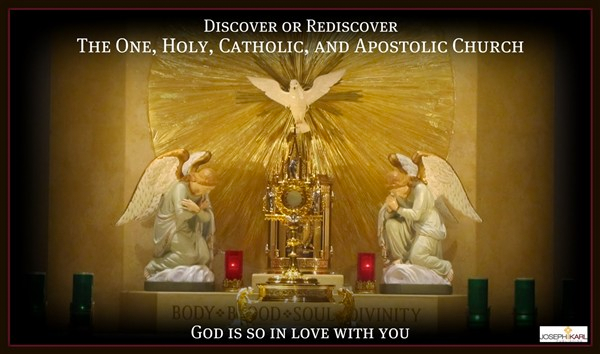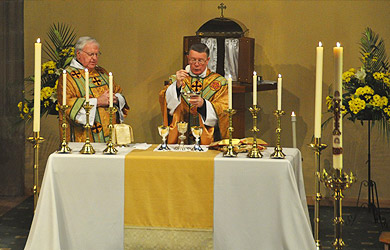The Diocese of Lancaster aims to proclaim the Gospel of Jesus Christ, celebrates His Sacraments, and exercises His works of mercy, so that all might participate in His salvation and discover the lasting joy of a relationship with Him.

Describing Catholicism
If someone walked up to you and asked, “What is Catholicism?” How would you respond?
In today’s tech-savvy and sometimes short-attention-span world, coming up with a 140-character Tweetable answer would be tough. On top of that, many people—even those raised in the Catholic faith—never benefitted from a solid education and understanding of the faith.
At the heart of asking “What is Catholicism?” are several more paramount questions:
- Who is Jesus Christ?
- Why should I develop a relationship with Him?
- How do I best know Him, love Him and serve Him?
- And what is Catholicism anyway?
If you look in the Catechism of the Catholic Church, you’ll read that the Catholic Church is “The Church established by Christ on the foundation of the Apostles, possessing the fullness of the means of salvation which he has willed: correct and complete confession of faith, full sacramental life, and ordained ministry in apostolic succession” (p. 830).
A Catechism is a summary or exposition of doctrine and serves as a learning introduction to the Sacraments traditionally used in catechesis, or Christian religious teaching of children, adult converts and on-going formation.

More simply, Scripture describes four characteristics which are proclaimed in the Nicene Creed. These four characteristics are all found in the Catholic Church.
The Catholic Church is One, Holy, Catholic, and Apostolic.
If you understand the four marks of the Church, that leads to a deeper understanding and appreciation on areas such as the Authority of the Church, Eucharist, Confession, Priesthood, Marriage, Family and more.
The Catechism of the Catholic Church is organized into four main pillars. Just as the four pillars of any building are an important part of its foundation so are the four pillars of “The Catechism of the Catholic Church” an important part of what we believe as Catholics.

The First Pillar: The Creed — The Faith Professed
When we pray or recite the Creed, we can be reminded that Catholicism is a revealed religion. God is the author of our faith. All that we are expected to believe is summed up in the revelation of Jesus Christ. God has spoken all that is necessary for our Salvation in Jesus, the Word made flesh. God also gives us the gift of faith that enables us to respond, accept, and live out the implications of Divine Revelation. In the first section of the books, the roles of Apostolic Tradition, Scripture, and Magisterium are clearly outlined.

The Second Pillar: The Sacraments — The Faith Celebrated
In the second section of the text it deals with the celebration of the Christian mystery in the liturgy and the Sacraments. Through the Sacraments the Holy Spirit makes available to us the mysteries of God’s revelation in Christ. The saving gifts of Christ’s ministry are encountered in the liturgy and are available to us. This is evident in the Sacraments of Initiation (Baptism, Confirmation, the Eucharist), the Sacraments of Healing (Penance and the Anointing of the Sick), and the Sacraments at the Service of Communion (Marriage and Holy Orders). Through the Sacraments, God shares his holiness with us so that we, in turn, can make the world holier.

The Third Pillar: The Christian Morality — The Faith Lived
The third section in the books offers an extensive exposition of the foundations of the Christian moral life. Themes of covenant, grace, happiness, sin, forgiveness, virtues, the action of the Holy Spirit, the call to love God and neighbour, the dignity of the person, and the Church’s social teachings are part of the foundational elements for morality. Subsequently, when the Ten Commandments are presented, it us easier to see how the Covenant with God comes first and how the Commandments are ways in which we live out this Covenant. In the Sermon on the Mount, Jesus presents to us a summary of the New Covenant in the Beatitudes. Hence, the Commandments are more than moral laws; our commitment to living them flows from our response to the Covenant we have with God, as members of the Church strengthened by the Holy Spirit.
The Fourth Pillar: Prayer: The Faith Prayed
The last section in both books bears an essential relationship to the second section on the liturgy, which is the prayer life of the Church herself. This section deals with vocal prayer, meditation and contemplation, and the types of prayer – adoration, petition, intercession, thanksgiving, and praise. A special chapter is devoted to a commentary on the Our Father, which is the Lord’s Prayer. It seemed suitable here to acknowledge the special link between doctrine and prayer so that a Church teaching is not seen as an abstract idea, and so that prayer not be without a solid doctrinal foundation.


